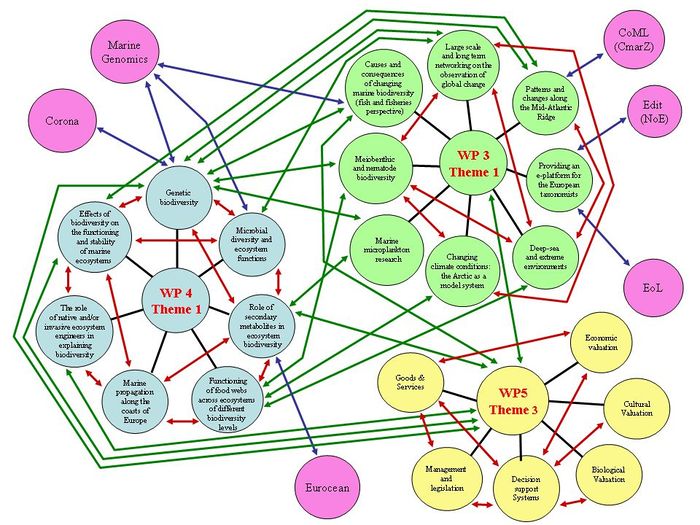MarBEF approach
Europe has a rich history of marine biodiversity research, a history of many research institutes independently developing and accumulating expertise and knowledge at local or regional level. However, in recent years a consensus has grown that integration and co-ordination at European scale is urgently required to implement long-term and large-scale marine biodiversity research and to plan more effective use of the European research infrastructure. Many research questions cannot be addressed at local scales: they require cooperation and the establishment of a committed network of scientists and institutes.
Better integration of research is also required to support the legal obligations of the EU and its member states, and also of associated states which are signatories to the Convention for Biological Diversity and the OSPAR and Barcelona Conventions. The legal obligations include several EU directives: the Birds Directive, Habitats Directive, Water Framework Directive and the forthcoming Marine Strategy Framework Directive.
Such integration could also provide improved links and resources to the large and growing number of industries dependent on the sustainable use and exploitation of marine biodiversity. These include existing tourism, fisheries and aquaculture industries, all of which are developing, but also new industries which are exploring and commercialising marine genetic and chemical products.[1]
Contents
Research integration
MarBEF adopted a phased approach to addressing its identified research priorities. Three research themes were identified, namely: Global Patterns of Marine Biodiversity Across Ecosystems; Marine Biodiversity and Ecosystem Functioning; and the Socio-economic Importance of Marine Biodiversity. Each of these themes began with a Core Strategic Programme (CSP), the major integration activity for joint research, which was respectively: Spatial and Temporal Patterns in European Marine Biodiversity; Comparative Analysis of Marine Biodiversity and Ecosystem Functionality; and Valuation of Marine Biodiversity and Marine Ecosystem Management. The CSP engaged a large proportion of the MarBEF members and guaranteed that MarBEF focused on and devoted major resources to meeting the priority objectives and deliverables.
In the second year, this top-down approach was combined with a bottom-up approach where key areas for responsive action were identified and Responsive Mode Projects (RMP) established, including some outstanding smaller-scale projects. The areas of research were particularly relevant to MarBEF’s objectives and, combined with the (CSP), provided a more comprehensive research result for each of the three programme themes.
In the third year, both the CSP and RMP programmes identified many different issues of importance to marine biodiversity and obtained concrete results. It became clear that all should be further combined and integrated to better increase our understanding of marine biodiversity, and so it was agreed to combine the findings.[1]

The products
In addition to standard scientific output, MarBEF has promoted dissemination of research results, and as the network has grown, the amount and complexity of data has increased dramatically. This has been handled by a dedicated team of specialists serving the entire MarBEF community. In addition to their internal work, these specialists have provided an open gateway to MarBEF resources and data through web-based information. MarBEF has fully embraced the potential of the internet to provide integration, dissemination and education systems.
Future integration: beyond Framework Programme 7
The MarBEF community formulated a list of priority issues for EU Framework Programme 7 (FP7) which has been submitted to the European Commission and to the Marine Board of the European Strategy Forum (ESF). MarBEF has excellent and regular contact with its sister networks Euroceans, Marine Genomics Europe(MGE) and Alternet, and has participated in their meetings. Together with Euroceans, MGE and the ERA-net Marinera, the discussion on the creation of a virtual European Institute in Marine Sciences (MarBEF+) has started in four working groups, and a first overview will be made available as a Position Paper.
The MarBEF community has also composed a range of potential pre-proposals linked to the RMP programmes. MarBEF has elaborated, together with five other NoEs, a proposal to create a network of observatories and collections called LifeWatch. For the foundation of LifeWatch, a proposal will be submitted to the first call from FP7. MarBEF members have also contributed to the discussion on the Green Paper on the future Maritime Strategy of the EC.[1]
References
- ↑ 1.0 1.1 1.2 Heip, C., Hummel, H., van Avesaath, P., Appeltans, W., Arvanitidis, C., Aspden, R., Austen, M., Boero, F., Bouma, TJ., Boxshall, G., Buchholz, F., Crowe, T., Delaney, A., Deprez, T., Emblow, C., Feral, JP., Gasol, JM., Gooday, A., Harder, J., Ianora, A., Kraberg, A., Mackenzie, B., Ojaveer, H., Paterson, D., Rumohr, H., Schiedek, D., Sokolowski, A., Somerfield, P., Sousa Pinto, I., Vincx, M., Węsławski, JM., Nash, R. (2009). Marine Biodiversity and Ecosystem Functioning. Printbase, Dublin, Ireland ISSN 2009-2539